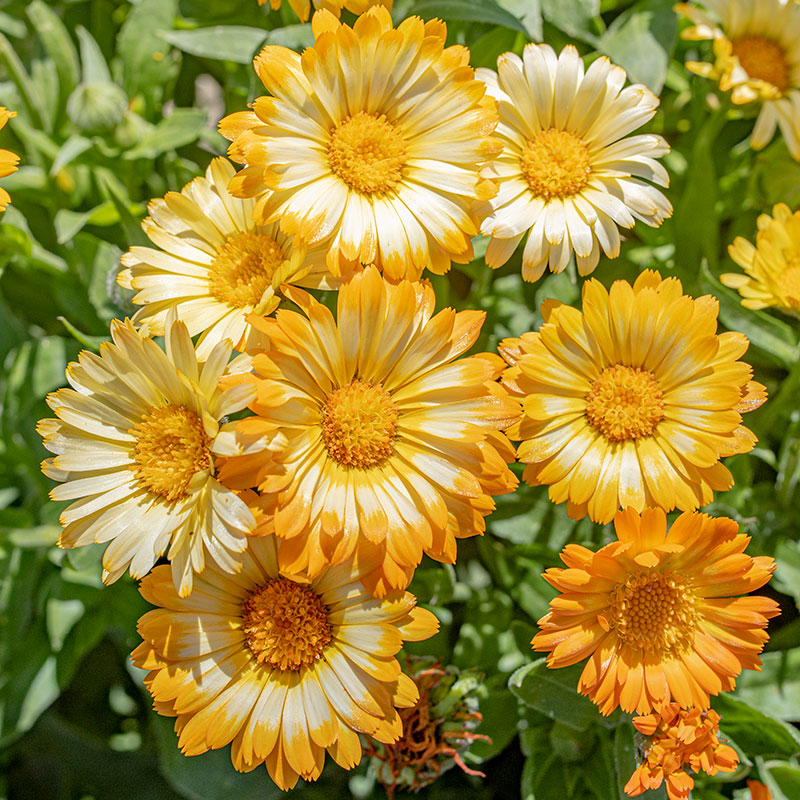How to Plant Daisy Seeds Varieties and Factors for Successful Germination
Daisies, with their vibrant petals and cheerful disposition, are a popular choice for gardeners of all levels. Whether you're looking to add a splash of color to your borders, attract pollinators to your garden, or simply enjoy the beauty of these cheerful flowers, daisy seeds offer endless possibilities.
From classic English daisies to bright and bold African daisies, there are numerous varieties and factors that can influence the successful germination of daisy seeds. In this article, we will explore the different types of daisy seeds and the key factors to consider for optimal germination. So let's dig in and learn how to plant daisy seeds like a pro!
Daisy Seeds: A Variety to Suit Every Garden
Daisy seeds come in a wide range of sizes, shapes, and colors, making them a versatile and attractive addition to any garden. Here are some of the most popular varieties of daisy seeds:
Common Daisy (Bellis perennis)
Also known as English daisy, this classic variety is a perennial flower with compact growth habit and delicate white, pink, or red blooms. It is a popular choice for cottage gardens and can also be grown in containers.
Gerbera Daisy (Gerbera jamesonii)
Gerbera daisies are well-known for their large, showy flowers in a rainbow of colors including yellow, orange, red, pink, and white. They are often used as cut flowers due to their long vase life and make a stunning addition to any bouquet.
African Daisy (Osteospermum ecklonis)
Native to South Africa, African daisies are prized for their heat tolerance and drought resistance. They come in a wide range of colors, including white, yellow, pink, purple, and orange, making them a popular choice for borders, containers, and rock gardens.
Shasta Daisy (Leucanthemum x superbum)
Shasta daisies are a favorite among gardeners for their large, white blooms and long flowering period. They can reach up to 3 feet in height, making them a great choice for adding height and drama to flower beds and borders.
Black-Eyed Susan (Rudbeckia hirta)
With its cheerful yellow petals and dark brown central cones, the black-eyed Susan is a must-have for any pollinator-friendly garden. These daisies are loved by butterflies and other pollinators and can be grown in a variety of soil types.
Other popular varieties of daisy seeds include:
- Giant Daisy (Argyranthemum spp.)
- Blue-Eyed Daisy (Felicia amelloides)
- Painted Daisy (Tanacetum coccineum)
- Paris Daisy (Argyranthemum frutescens)
- Swan River Daisy (Brachyscome iberidifolia)
- Aster Daisy (Aster spp.)
- Cape Daisy (Osteospermum spp.)
- Tahoka Daisy (Machaeranthera tanacetifolia)
- Montauk Daisy (Nipponanthemum nipponicum)
- Prairie Daisy (Ratibida spp.)
With this variety of daisy seeds available, you can easily find the perfect fit for your garden.
Factors Influencing Daisy Seeds Germination

While daisy seeds are relatively easy to grow, there are some important factors that can influence their germination. Here are the key things to consider when planting daisy seeds:
Soil Type and Condition
Daisy seeds prefer well-draining soil with a slightly acidic pH level (around 6.0 to 6.5). The ideal soil should be loose, light, and fertile, allowing for good air circulation and water drainage. Avoid heavy or clay soils, which can cause waterlogging and hinder seed germination.
Before planting daisy seeds, prepare the soil by removing any weeds, rocks, or debris and adding organic matter such as compost or aged manure. This will provide essential nutrients for the seeds to grow and thrive.
Sunlight and Temperature
Most varieties of daisy seeds require full sun to grow and bloom. Make sure to plant them in an area that receives at least 6 hours of sunlight per day. Lack of sunlight can result in weak and spindly plants with fewer flowers.
In terms of temperature, daisy seeds prefer cool to moderate temperatures for optimal germination. The ideal temperature range is between 60-70°F (15-21°C). If you live in a hot climate, consider planting daisy seeds in early spring or fall when the temperatures are cooler.
Watering and Moisture
Daisy seeds need consistent moisture for successful germination, but be careful not to overwater them. The soil should be kept evenly moist, but not soggy, as excess water can lead to rotting of the seeds.
To keep the soil moist, water your daisy seeds lightly once or twice a day until they have germinated. After that, you can reduce the frequency of watering to a few times a week, depending on the weather conditions.
Time of Planting
The timing of planting daisy seeds can also impact their germination success. Generally, it's best to sow the seeds in late spring or early summer after the last frost has passed. This will give the seeds enough time to establish and develop before the colder months arrive.
However, some varieties of daisy seeds, such as African daisies, can also be planted in fall for early spring germination. Check the specific instructions on the seed packet for the best time to plant according to your climate and the variety of daisy seeds.
Seed Depth
The depth at which you plant daisy seeds is crucial for their germination. Too deep, and they may not have enough energy to push through the soil; too shallow, and they may dry out quickly or be eaten by birds.
As a general rule, daisy seeds should be planted at a depth equal to 2-3 times their size. This means that smaller seeds will need to be planted closer to the surface, while larger seeds can be planted deeper.
Seed Scarification and Stratification
Some varieties of daisy seeds, such as black-eyed Susans, may require scarification or stratification for successful germination. Scarification involves slightly damaging the seed coat to allow for better water absorption, while stratification refers to subjecting the seeds to a period of cold temperatures before planting.
If your daisy seeds require either of these processes, make sure to follow the instructions on the seed packet or do some research beforehand to ensure proper handling.
How to Plant Daisy Seeds Step by Step

Now that we know about the different varieties and factors influencing daisy seeds germination, let's go through the step-by-step process of planting them:
Step 1: Prepare the Soil
Choose a sunny spot in your garden with well-draining soil. Remove any debris, rocks, or weeds from the area, and loosen the soil to a depth of 6-8 inches.
Add organic matter, such as compost or aged manure, and mix it with the soil. This will provide essential nutrients for the seeds to thrive.
Step 2: Sow the Seeds
Using a small hand rake or your fingers, create shallow furrows in the prepared soil. The depth of the furrows should be equal to 2-3 times the size of the seeds.
Place the seeds in the furrows, leaving about 2-3 inches of space between each seed. Cover the seeds gently with soil, and lightly pat them down.
Step 3: Water the Seeds
After planting, water the seeds lightly using a watering can or a gentle spray from a hose. Make sure not to overwater, as this can cause the seeds to float away or become dislodged.
Continue to water the seeds regularly, keeping the soil moist but not waterlogged, until they have germinated.
Step 4: Thin the Seedlings
Once the seedlings have emerged, thin them out to allow for proper air circulation and prevent overcrowding. This will also help the daisy plants to grow strong and healthy.
For smaller varieties, leave a space of about 6 inches between each seedling, and for larger varieties, leave a space of 12 inches.
Step 5: Care for the Plants
As your daisy plants grow, continue to water them regularly and keep the soil moist. You can also add a layer of mulch around the plants to help retain moisture and prevent weed growth.
Fertilize your daisies every 2-3 weeks with a balanced liquid fertilizer to promote healthy growth and abundant blooms.
Tips for Growing Healthy Daisy Plants
- Plant daisy seeds in groups or clumps rather than single rows to create a fuller and more natural look.
- Deadhead (remove spent flowers) your daisy plants regularly to encourage continuous blooming.
- To save seeds for next year's planting, allow some of the flowers to form seed heads, and collect the seeds once they are dry.
- Some varieties of daisy plants can be divided every few years to rejuvenate them and create new plants.
Now that you know how to plant daisy seeds successfully, let's take a closer look at some popular varieties and their specific requirements for optimal germination.
Common Daisy (Bellis perennis)
Germination Time: 7-14 days Sowing Depth: 1/8 inch Sowing Season: Spring and fall Preferred Soil Temperature: 55-60°F (13-16°C) Light Requirements: Full sun to partial shade Moisture Requirements: Moist, well-drained soil
Shasta Daisy (Leucanthemum x superbum)
Germination Time: 10-15 days Sowing Depth: 1/4 inch Sowing Season: Spring and fall Preferred Soil Temperature: 65-75°F (18-24°C) Light Requirements: Full sun Moisture Requirements: Moist, well-drained soil
African Daisy (Osteospermum ecklonis)
Germination Time: 7-14 days Sowing Depth: 1/4 inch Sowing Season: Spring and fall Preferred Soil Temperature: 70-75°F (21-24°C) Light Requirements: Full sun Moisture Requirements: Moist, well-drained soil
Black-Eyed Susan (Rudbeckia hirta)
Germination Time: 5-10 days Sowing Depth: Surface sow or barely cover seeds with soil Sowing Season: Early spring or fall Preferred Soil Temperature: 70-75°F (21-24°C) Light Requirements: Full sun Moisture Requirements: Moist, well-drained soil
Conclusion

Daisy seeds offer a beautiful and versatile addition to any garden. With their vibrant colors and cheerful blooms, they are a popular choice for gardeners of all levels. By considering the various factors influencing germination and following the steps outlined in this article, you can successfully grow a variety of daisies in your garden.
From preparing the soil to caring for the plants, every step is crucial for the successful germination of daisy seeds. So go ahead and take your pick from the wide range of daisy seed varieties available and start planting today! Happy gardening!


Leave a comment